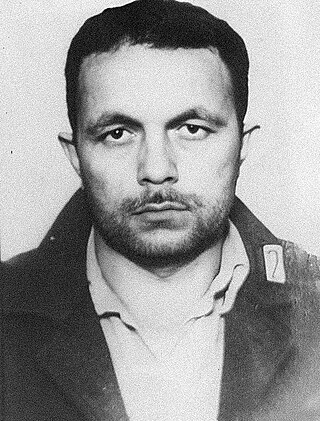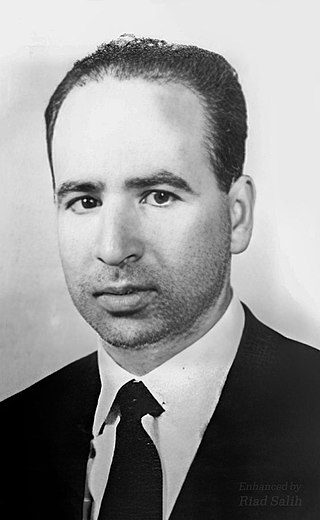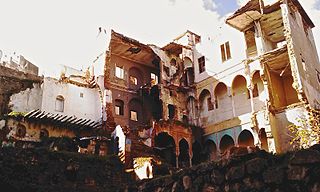Articles related to Algeria include:

The National Liberation Front commonly known by its French acronym FLN, is a nationalist political party in Algeria. It was the principal nationalist movement during the Algerian War and the sole legal and ruling political party of the Algerian state until other parties were legalised in 1989.

Ahmed Ben Bella was an Algerian politician, soldier and socialist revolutionary who served as the head of government of Algeria from 27 September 1962 to 15 September 1963 and then the first president of Algeria from 15 September 1963 to 19 June 1965.

Abane Ramdane was an Algerian political activist and revolutionary. He played a key role in the organization of the independence struggle during the Algerian war. His influence was so great that he was known as "the architect of the revolution". He was also the architect of the Soummam conference Bejaia in 1956 and was very close to Frantz Fanon.

Krim Belkacem was the historic leader of the National Liberation Front during the Algerian War. As vice-president of the GPRA, he was the sole signatory of the Évian Accords on the Algerian side. After the 1965 coup d'état, he went into exile and was assassinated in Germany in 1970.

Larbaâ Nath Irathen is a town in Tizi Ouzou Province, in the central part of northern Algeria. It was formerly known as Fort National. The population in 2002 was 29,773, The area is renowned for its majestic scenery.

Larbi Ben M'hidi, commonly known as Si Larbi or simply as Ben M'hidi, was a prominent Algerian revolutionary leader during the Algerian war of independence. He is one of the six founding members of the Front de Libération Nationale that launched an armed revolt throughout Algeria and issued a proclamation calling for a sovereign Algerian state.
The Étoile Nord-Africaine or ENA was an early Algerian nationalist organization founded in 1926. It was dissolved first in 1929, then reorganised in 1933 but was later finally dissolved in 1937. It can be considered a forerunner of the Algerian National Liberation Front (FLN), who fought France during the Algerian War (1954–62).

The Kabyle people are a Berber ethnic group indigenous to Kabylia in the north of Algeria, spread across the Atlas Mountains, 160 kilometres (100 mi) east of Algiers. They represent the largest Berber population of Algeria and the second largest in North Africa.

The Provisional Government of the Algerian Republic was the government-in-exile of the Algerian National Liberation Front (FLN) during the latter part of the Algerian War of Independence (1954–62).

Benyoucef Benkhedda was an Algerian politician. He headed the third GPRA exile government of the National Liberation Front (FLN), acting as a leader during the Algerian War (1954–62). At the end of the war, he was briefly the de jure leader of the country, however he was quickly sidelined by more conservative figures.

The Battle of Algiers was a campaign fought during the Algerian War. It consisted of urban guerrilla warfare and terrorist attacks carried out by the National Liberation Front (FLN) against the French authorities in Algiers, and by the French authorities, army, and French terrorist organizations against the FLN. Both sides targeted civilians throughout the battle. The conflict began with attacks by the FLN against the French forces and Pieds-Noirs followed by a terrorist attack on Algerian civilians in Algiers by a group of settlers, part of the terrorist group "La Main Rouge", aided by the police. Reprisals followed and the violence escalated, leading the French Governor-General to deploy the French Army in Algiers to suppress the FLN. Civilian authorities gave full powers to General Jacques Massu who, operating outside legal frameworks between January and September 1957, eliminated the FLN from Algiers. The use of torture, forced disappearances and illegal executions by the French later caused controversy in France.

Dr. Mohamed Lamine Debaghine was an Algerian politician and independence activist.
Revolutionary Committee for Unity and Action was a militant group in Algeria formed in order to fight French rule. CRUA regrouped former elements of the OS and radical members of the MTLD. The CRUA was founded by 33 persons.

Ali Boumendjel was an Algerian revolutionary and lawyer.
Petit Omar or Little Omar was the nickname of Yacef Omar (1944–1957), a notable figure of the Algerian War for Independence.
Ahmed Mahsas was an Algerian militant in the nationalist movement against French Algeria.

Mostéfa Merarda, nicknamed Bennoui, was born on August 21, 1928 and died on May 18, 2007. He was a commander and acting chief of Wilayah I during the Algerian War. The second of his siblings, he was educated at a school in the town of Batna. At the age of 17, he married his cousin and became a farmer, before joining the independence movements that led to the Algerian War.













